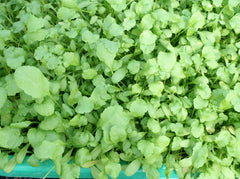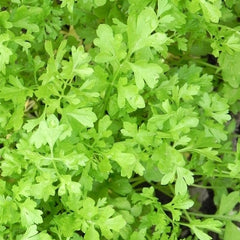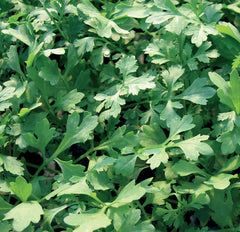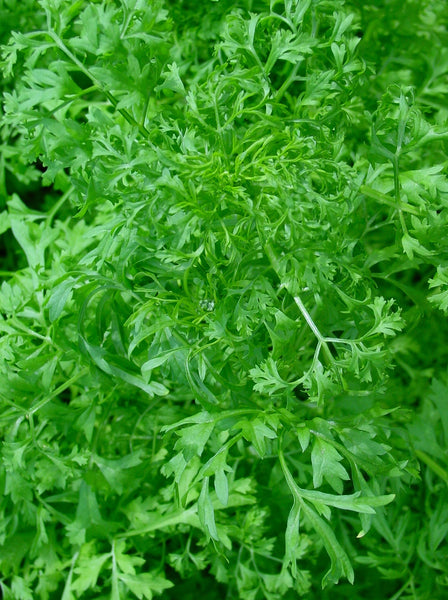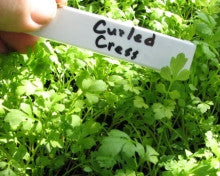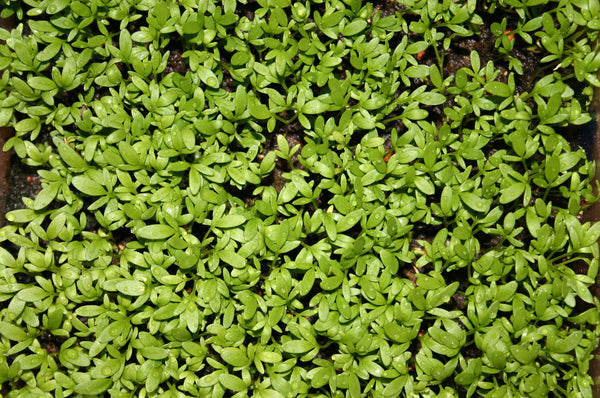Fine Curled garden cress
HOW TO GROW GARDEN CRESS
Direct sow in the spring as soon as the ground can be work or outdoors in the fall. Broadcast seed and cover very lightly with soil or compost. A small patch, 1–2’ square, provides plenty of cress. Edible shoots are typically harvested in one to two weeks after planting, when they are 2–5” tall (5–13 cm). Fast growing herb, can mature in 20-30 days from sowing. Also quick to bolt so requires frequent successional sowings. You can intercrop cress with carrots or radishes, or mix it with other salad green crops. Keep well watered and provide shade when weather warms. Cover with fabric row covers if flea beetles or other pests are a problem. Soil pH 5.6–7.5. Hardiness zones 7. Annual.
Usual seed life: 5 years.
Planting Depth 1/4–1/2"
Soil Temp. Germ. 55–75˚F
Days to Germ. 2–7
Plant Spacing 3–6”
Row Spacing 12–18”
Days To Maturity 20–30
Full Sun, Moist Well Drained Soil
Usual seed life: 5 years.
Planting Depth 1/4–1/2"
Soil Temp. Germ. 55–75˚F
Days to Germ. 2–7
Plant Spacing 3–6”
Row Spacing 12–18”
Days To Maturity 20–30
Full Sun, Moist Well Drained Soil
Fine Curled Seed Count
.25 Pound ≈ 51,545 seeds
1 Ounce ≈ 12,886 seeds
- 250 Seeds$4.10
- 2500 Seeds$12.50
- 1 Ounce$26.00
- 1/4 Pound$42.00
Quick-growing, high-yielding type with large, smooth leaves. After harvest the product remains stable relatively long. Garden cress is added to soups, sauces, sandwiches and salads for its tangy flavor. It is also eaten as sprouts, and the fresh or dried seed pods can be used as a peppery seasoning. In England, cut ...
Quick-growing, high-yielding type with large, smooth leaves. After harvest the product remains stable relatively long. Garden cress is added to soups, sauces, sandwiches and salads for its tangy flavor. It is also eaten as sprouts, and the fresh or dried seed pods can be used as a peppery seasoning. In England, cut cress shoots are commonly used in sandwiches with boiled eggs, mayonnaise and salt. Plants exhibits a compact growth of dark green, flat dissected leaves. Garden cress is genetically related to watercress and mustard, sharing their peppery, tangy flavor and aroma. But is not to be confused with watercress. Garden cress seeds called halloon are bitter, tonic and diuretic. They are useful in the treatment of asthma, poultices for sprains, skin disease, diarrhea, and scurvy. Tags: Color: Green, Specialty: Sprouting, Season: Spring Fall
Native to Egypt and Middle East, cultivated in Persia around 400 B.C. Spread many centuries ago to western Europe. The word cress is from old germanic cresso which means sharp, spicy. Garden cress seeds, since ancient times, have been used in local traditional Ayurvedic medicine of India. Today Garden cress is commercially grown in England, France, the Netherlands and Scandinavia. Garden cress is suitable for hydroponic cultivation and thrives in slightly alkaline water. In many local markets, the demand for hydroponically grown cress can exceed available supply, partially because cress leaves are not suitable for distribution in dried form, so can be only partially preserved. Consumers commonly acquire cress as seeds or (in Europe) from markets as boxes of young live shoots. Delicious garden cress recipes.
Native to Egypt and Middle East, cultivated in Persia around 400 B.C. Spread many centuries ago to western Europe. The word cress is from old germanic cresso which means sharp, spicy. Garden cress seeds, since ancient times, have been used in local traditional Ayurvedic medicine of India. Today Garden cress is commercially grown in England, France, the Netherlands and Scandinavia. Garden cress is suitable for hydroponic cultivation and thrives in slightly alkaline water. In many local markets, the demand for hydroponically grown cress can exceed available supply, partially because cress leaves are not suitable for distribution in dried form, so can be only partially preserved. Consumers commonly acquire cress as seeds or (in Europe) from markets as boxes of young live shoots. Delicious garden cress recipes.
Learn More
Meet Your Farmer
We promote fair trade, organic practices and environmental responsibility throughout the Restoration Seeds supply chain. Below are the family farmers and seed suppliers who bring our open pollinated seeds to you.
Sugi Lumina Grace
Conventional
Seed grower since 2021


Gardening since age 8, I have always had a passion for plants. I began dedicating my energy toward wild-tending and homesteading with a focus on year-round food sustainability in 2006. Now settled in Ashland, Oregon, I have been enjoying adding the seed-saving cycle to my gardening season. I use only natural products in my small garden with a lot of manually tended care.My other work is as a massage therapist: Appointments | Sugi Lumina Grace, LLC
Reviews
